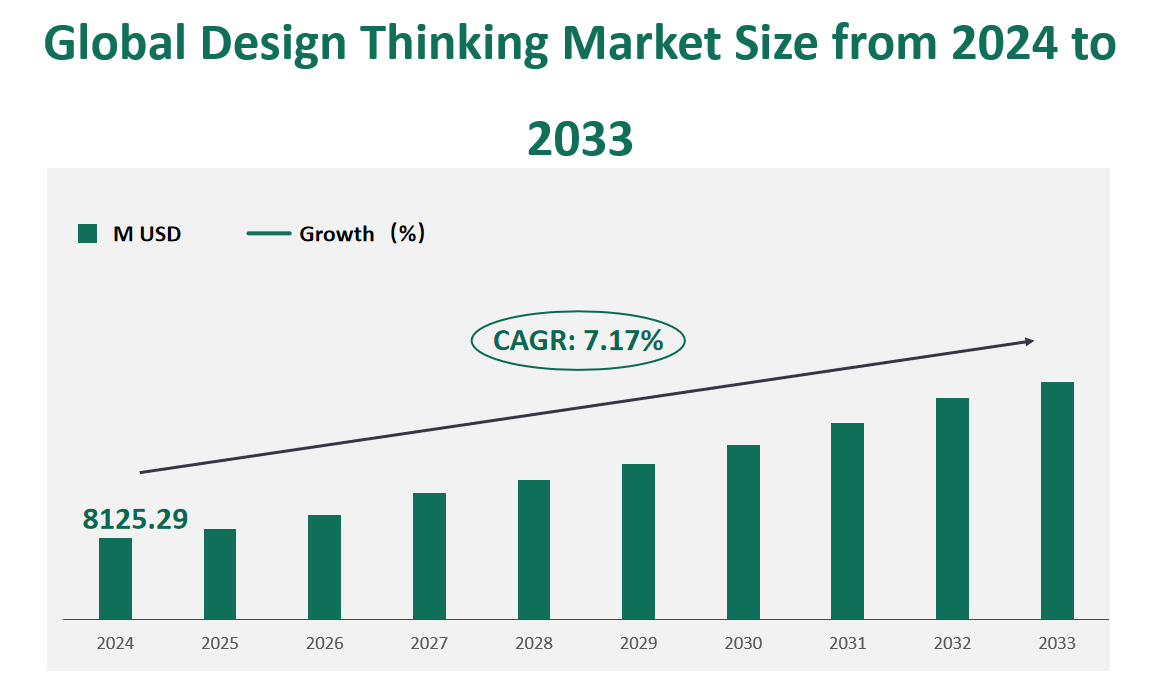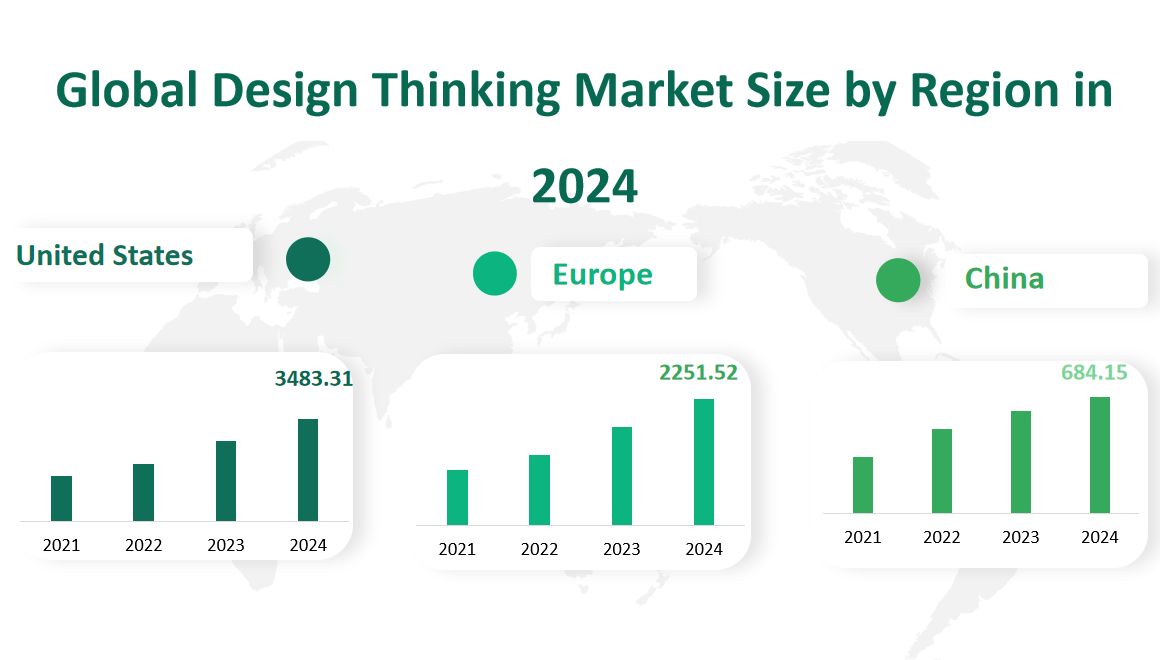1 Global Design Thinking Market Insight Analysis
In 2024, the global Design Thinking Market is projected to reach a value of $8,125.29 million USD, with CAGR of 7.17% from 2024 to 2033.
Thinking like a designer can transform the way organizations develop products, services, processes, and strategy. This approach, which is known as design thinking, brings together what is desirable from a human point of view with what is technologically feasible and economically viable. It also allows people who aren’t trained as designers to use creative tools to address a vast range of challenges. Design thinking is a human-centered approach to innovation that draws from the designer’s toolkit to integrate the needs of people, the possibilities of technology, and the requirements for business success.
Figure Global Design Thinking Market Size (M USD) and CAGR (2024-2033)

2 Design Thinking Market Growth Drivers and Restraints
The Design Thinking market is experiencing significant growth, driven by a multitude of factors. At the core, the increasing recognition of the value of customer experience and the need for agile innovation cycles are propelling the demand for Design Thinking methodologies. Businesses across various sectors are adopting design thinking to foster creativity and efficiency in product development, service enhancement, and process optimization. The integration of design thinking into organizational culture is promoting a shift towards user-centric solutions, which is expected to continue driving market growth.
Another key driver is the growing importance of cross-disciplinary collaboration and co-creation in the design process. Organizations are realizing the benefits of diverse perspectives in encouraging creativity and problem-solving, leading to the adoption of design thinking in various business functions beyond product creation, such as marketing and organizational culture.
However, the market faces several limitations. The high capital requirement for developing competitive Design Thinking tools and techniques presents a significant barrier to new entrants. The market is still in its infancy, lacking clear guidelines and regulations, which increases the risk and investment needed for companies to establish a foothold. Additionally, finding experienced and qualified personnel to manage and execute Design Thinking programs is a challenge, as the training of such talents requires long-term practical accumulation. The high talent barrier has been a deterrent for companies looking to quickly expand into new markets.
The content and requirements of Design Thinking services vary across different industry sectors, making it difficult to scale certain measures in the industry. This variability in service needs and the customization required for different clients present operational challenges and limit the scalability of Design Thinking solutions.
3 Technological Innovations and Mergers in the Design Thinking Market
Technological innovations are playing a pivotal role in shaping the Design Thinking market. The integration of artificial intelligence (AI) and machine learning (ML) into design thinking techniques is a notable trend. AI tools and algorithms are being used to enhance the ideation, prototyping, and testing phases of the design process, automating tedious operations, and providing deeper insights from data. This technological advancement is enabling practitioners to come up with more creative solutions to complex problems and is expected to further transform the industry.
Sustainability and ethical design principles are also gaining traction, with design thinking methodologies evolving to prioritize environmentally friendly solutions, social responsibility, and inclusivity in product and service design. Companies are incorporating sustainability metrics and circular economy principles into their design processes to address global issues and meet the needs of socially conscious consumers.
Mergers and acquisitions are another significant aspect of the market’s evolution. These strategic moves are helping companies to expand their service offerings, strengthen their market positions, and gain access to new technologies and talent. For instance, VRIZE’s acquisition of Perfomatix is a prime example of how companies are leveraging M&A to enhance their product and platform engineering services and to provide cutting-edge data engineering and data science solutions to their customers.
The collaboration between Capgemini and Salesforce to enable a new era of generative AI-powered customer experiences is another example of how technological innovation and strategic partnerships are driving the Design Thinking market forward. These collaborations are not only enhancing the capabilities of the companies involved but also contributing to the overall growth and advancement of the industry.
In summary, while the Design Thinking market is growing rapidly, it is also facing challenges that need to be addressed to ensure sustained growth. Technological innovations and strategic are key factors that will continue to shape the market’s future, providing opportunities for companies to differentiate themselves and offer more value to their clients.
4 Global Design Thinking Market Size by Type
For the software segment, the market value is projected to reach $1,840.38 million USD in 2024. This segment encompasses design thinking software that assists companies in creating innovative solutions and products by applying design thinking principles. Such software offers analytic tools and capabilities that allow users to design, test, and assess new solutions, products, and processes, optimizing design outcomes. The software segment is expected to grow at a CAGR of 8.74% from 2024 to 2033, indicating a robust expansion in the adoption of design thinking tools facilitated by technological advancements and the need for streamlined innovation processes.
On the other hand, the services segment is predicted to command a market value of $6,284.91 million USD in 2024. Design thinking services involve collaborative efforts between design teams and clients to address complex issues arising from product or service environments. These services include analyzing user needs, researching necessary data, creating prototypes, and testing solutions. The services segment is anticipated to grow at a CAGR of 6.68% from 2024 to 2033, reflecting the continuous demand for professional design thinking services to enhance customer experiences and optimize productivity, process efficiency, cost-effectiveness, and scalability.
In terms of market share, while the software segment is expected to grow, the services segment will continue to dominate, accounting for a larger portion of the market. The market share of the software segment in 2024 is projected to be 22.65%, while the services segment will capture 77.35% of the market. This disparity highlights the prevalent reliance on specialized services to implement design thinking principles effectively within organizations.
Table Global Design Thinking Market Size and Share by Type in 2024
Type | Market Size (M USD) 2024 | CAGR (2024-2033) |
|---|---|---|
Software | 1840.38 | 8.74% |
Services | 6284.91 | 6.68% |
5 Global Design Thinking Market Size by Application
With a forecasted market value of $2,038.64 million USD, BFSI is projected to lead the application segments, capturing 25.09% of the total market share. The sector’s rapid digital transformation and the need for innovative solutions are driving this growth.
The automotive industry is expected to generate $478.58 million USD, with a market share of 5.89%. Design Thinking is instrumental in creating innovative designs and enhancing customer experiences in this sector.
Consumer Electronic is forecasted to reach $1,000.22 million USD, holding a 12.31% market share. The focus on user-centered design and product development is a key factor in this growth.
With a market value of $809.28 million USD, healthcare is projected to have a 9.96% share. Design Thinking is crucial in creating customer-centric healthcare solutions.
Retail and E-commerce is expected to generate $708.53 million USD, capturing 8.72% of the market. The application of design thinking in enhancing customer experiences and operational efficiency is significant.
The manufacturing sector is anticipated to reach $1,282.17 million USD, with a 15.78% market share. Design Thinking aids in creating efficient and cost-effective manufacturing solutions.
Table Global Design Thinking Market Size and Share by Application in 2024
Application | Market Size (M USD) 2024 | Market Share 2024 |
|---|---|---|
BFSI | 2038.64 | 25.09% |
Automotive | 478.58 | 5.89% |
Consumer Electronics | 1000.22 | 12.31% |
Healthcare | 809.28 | 9.96% |
Retail and E-commerce | 708.53 | 8.72% |
Manufacturing | 1282.17 | 15.78% |
Others | 1807.88 | 22.25% |
6 Global Design Thinking Market Size by Region
With a market value of $3,483.31 million USD, the US is expected to lead with a 42.87% share. The country’s strong emphasis on innovation and technology adoption is a key driver.
The European market is anticipated to generate $2,251.52 million USD, capturing 27.71% of the market. The region’s focus on sustainability and ethical design principles is influencing market growth.
China’s market value is projected to be $684.15 million USD, with an 8.42% share. The country’s rapid industrialization and technological development are contributing to this growth.
Japan is expected to generate $260.01 million USD, holding a 3.20% share. The market is driven by the country’s focus on consumer electronics and automotive industries.
With a market value of $137.89 million USD, India has a 1.70% share. The growing IT and software industries are significant factors in this segment.
Southeast Asia is anticipated to generate $91.00 million USD, with a 1.12% share. The increasing demand for design-led products and services is driving the market.
Latin America is expected to reach $399.76 million USD, capturing 4.92% of the market. The growing emphasis on technology and innovation is a key factor.
With a market value of $257.57 million USD, Middle East and Africa region holds a 3.17% share. The market is influenced by the region’s focus on economic diversification and investment opportunities.
Figure Global Design Thinking Market Size (M USD) by Region in 2024

7 Global Design Thinking Market Analysis by Major Players
7.1 IBM Corporation
Company Introduction and Business Overview:
IBM Corporation, established in 1911 and headquartered in the USA, is a multinational technology and consulting company that operates on a global scale, offering a wide range of software, consulting, infrastructure, and financing services.
IBM is known for its integrated solutions and services, with a strong focus on hybrid cloud and AI platforms that enable clients to realize their digital and AI transformations. The company has strategic partnerships with various hyperscalers, service providers, and software and hardware vendors, making it a leader in the Design Thinking market.
Products:
IBM Design Thinking is a scalable framework that focuses on discovering users’ needs and envisioning a better future through a continuous cycle of observing, reflecting, and making.
Market Performance in 2024:
In 2024, IBM Corporation is projected to have a Design Thinking value of $617.78 million USD, with a gross of $287.97 million USD and a gross margin of 46.61%.
7.2 Accenture
Company Introduction and Business Overview:
Accenture, founded in 1989 and headquartered in Ireland, is a global professional services company that provides a broad range of services and solutions in strategy, consulting, digital, technology, and operations.
Accenture is recognized for its management consulting, technology, and outsourcing services, with a strong emphasis on helping clients reinvent their businesses with advanced digital technologies and becoming data-driven.
Products:
Accenture’s Design Thinking methodology generates innovative solutions to complex business problems by exploring possibilities through logic, imagination, and intuition.
Market Performance in 2024:
Accenture is expected to achieve a Design Thinking value of $522.93 million USD in 2024, with a gross of $180.81 million USD and a gross margin of 34.58%.
7.3 Capgemini (Frog Design Inc.)
Company Introduction and Business Overview:
Capgemini, established in 1967 and headquartered in France, is a global leader in consulting, digital transformation, technology, and engineering services, with a strong presence in the Design Thinking market through its acquisition of Frog Design Inc.
Capgemini offers a comprehensive portfolio of services that leverage the power of generative AI to fuel innovation and accelerate business value and growth, with a focus on customer experience capabilities.
Products:
Capgemini’s Design Thinking services empower organizations to transform through human-centered design and build a culture of innovation, offering Organizational Design strategies and DesignOps frameworks.
Market Performance in 2024:
Capgemini (Frog Design Inc.) is projected to have a Design Thinking value of $228.64 million USD in 2024, with a gross of $92.41 million USD and a gross margin of 40.42%.





